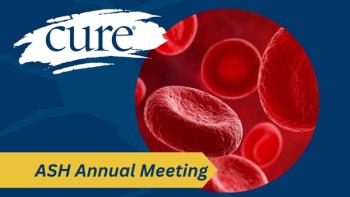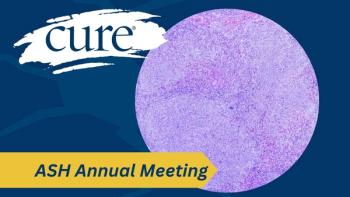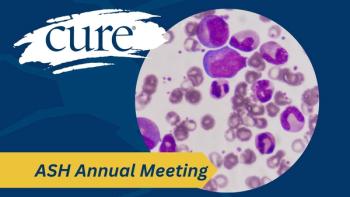
- CURE Fall 2023
- Volume 22
- Issue 04
First Cancer, Now Diabetes
Patients "need to be proactive" as they coordinate care between two diseases.
When Shawn* received a diagnosis of a neuroendocrine tumor in September 2022, he never imagined that just a year later, he would also be told he has diabetes.
“My doctors believe the immunotherapy I was receiving may have induced the diabetes,” says Shawn. “I’m currently successfully managing my diabetes with the help of an insulin pump.”
Although rare, Shawn’s dual diagnoses have been documented in other patients who undergo immunotherapy, which rarely cause the immune system to turn on certain tissues — including the islet cells in the pancreas which produce insulin.
Results of research published in the journal Diabetes found that after treatment with checkpoint inhibitors, approximately 1% of patients developed a type of insulin-dependent diabetes.
Dr. Zoe Quandt, an endocrinologist at the University of California San Francisco (UCSF) Medical Center, cares for patients, including Shawn, who develop hormonal side effects from their cancer treatments.
She says both cancer and subse- quent treatments can cause metabolic changes that trigger or aggravate high blood sugar.
“Immunotherapies have proven to be effective cancer treatments that work by enabling the patient’s own immune system to fight cancer,” Quandt says. “Since immunotherapies stimulate a patient’s immune system and kill cancer cells, they can also cause elevated blood sugar levels and present a challenge for physicians to treat.”
In addition to checkpoint inhibitors, research has found that medications used to fight cancer, including corticosteroids and phosphoinositide 3-kinase (PI3K) inhibitors, can also cause diabetes. Some forms of chemotherapy, including 5-fluorouracil, asparaginase, busulfan and cisplatin, have also been linked to high blood sugar levels.
Dr. Matthew P. Wahl, an endocrinologist with University of Utah Health in Salt Lake City, says corticosteroid medications such as dexamethasone, often prescribed to combat nausea during cancer treatment, have been shown to raise blood sugar levels in some patients.
“If patients see a rise in blood sugar, we will work with them to adjust their insulin (dosing as needed),” Wahl says. “In some cases, drug-induced diabetes may be reversible after the medication is discontinued, while in other cases it’s a permanent condition.”
Although secondary diabetes can be a side effect of some of the therapies used to treat cancer, Wahl says other patients with cancer may have undiagnosed diabetes prior to beginning treatment.
One study, published in 2021, found that approximately half of patients with cancer reported new onset of type 2 diabetes after cancer diagnosis and treatment.
“We know there are shared risk factors for cancer and diabetes including advanced age, obesity and smoking,” says Dr. Kevin Schleich, a clinical pharmacy specialist at the University of Iowa Hospitals & Clinics in Iowa City. “Some (patients with cancer) may have an underlying case of diabetes that wasn’t previously diagnosed or high blood sugar levels that were elevated to diabetic levels after beginning cancer treatment.”
Schleich says doctors closely monitor each patient’s daily blood sugar and A1C levels when they’re undergoing cancer treatment to ensure blood sugar levels are well-controlled and that patients don’t develop ketoacidosis.
“While we don’t want to see high glucose levels in the long-term, they’re sometimes tolerable for a couple of days, when a patient with type 2 diabetes is undergoing cancer treatment,” Schleich says. “If they’re already on insulin, we may slowly increase their insulin dosages, where other previously insulin-naïve patients may need the addition of insulin on cancer therapy days.”
Quandt and Dr. Robert Rushakoff, clinical director of the UCSF Diabetes Clinic at Mount Zion, collaborated with the UCSF Infusion Center to develop a hyperglycemia management protocol for patients with cancer experiencing elevated blood sugar levels. The protocol is provided through an urgent care site within the infusion center, and Quandt says their model can be replicated at other infusion centers to offer a rapid response for patients who experience a rapid rise in glucose levels.
According to the protocol, Quandt says the urgent care team must decide if the patient with cancer experiencing hyperglycemia should be sent to the emergency department or if they can safely be treated at the infusion center.
“The protocol helps providers determine the amount of insulin and fluids to give the patient so they can safely continue with their cancer treatment that day,” Quandt says. The protocol also promotes patient education by encouraging staff to teach patients how to use a glucometer and insulin pen and to provide individualized nutrition counseling.
Diet and Lifestyle Changes Can Make a Difference
With both diabetes and obesity on the rise, the World Health Organization recently noted that obesity may overtake smoking as the main risk for preventable cancer. High-quality diets have been shown to play a crucial role in preventing obesity, managing diabetes and lowering the risk of cancer.
According to the American Cancer Society and the American Diabetes Association, a diet containing fresh vegetables, whole grains, fruits, low-fat dairy or non-dairy products and lean meats can benefit patients who have been diagnosed with both cancer and diabetes. This type of diet can also reduce the risk of heart and kidney disease because diabetes, particularly type 2, increases the risk of developing these conditions.
“We always encourage patients to meet with a dietitian who can help them adopt a balanced meal plan,” Schleich says. “A dietitian can work with patients to devise an individual and consistent plan while also addressing issues such as what foods to eat in the event they feel nauseous or fatigued.”
Schleich notes that a patient’s blood sugar levels need to be well-managed during cancer treatments and that loss of appetite, a common side effect of cancer therapy, can lead to low blood sugar levels.
One recent study found that patients who had both advanced breast cancer and diabetes reported better long-term outcomes when their blood sugar levels were well- controlled, as opposed to those with uncontrolled blood sugar levels.
Quandt says this is where an individualized approach to helping patients with cancer control their diabetes comes into play.
“We like to see a patient’s A1C under 7% and we encourage them to give up habits such as smoking and alcohol that can make their prognosis worse,” she says. “Yet when a patient has done all of that and says sweets are the only thing left that gives them happiness, we’re going to determine how they can continue to enjoy ice cream without raising their blood sugar.”
One of the first things Quandt’s patient Shawn did shortly after receiving his cancer diagnosis was meet with a dietitian. He says the guidance he received was invaluable.
“My initial focus was on improving my diet and, as a result, managing my diabetes has been easier than I anticipated,” he says. “The dietitian
I consult with specializes in cancer care and believes my dietary focus will improve my long-term outcome.”
By learning how to best manage side effects of his cancer treatments and diabetes through diet, Shawn says he’s also been able to maintain an active lifestyle.
“Whenever I have free time, you can find me on the tennis courts or on my mountain bike,” he says. “I can’t emphasize enough how important good nutrition is. I truly believe it’s the Holy Grail to successfully treating and keeping cancer at bay.”
More Research Is Warranted
Although researchers have established a clear link between diabetes and cancer, Quandt says there’s a need for continued research into why some cases of diabetes seem to be a side effect of cancer treatments and what can be done to reduce the risk.
“Some research shows the diabetes medication metformin is associated with a decreased risk for all cancers,” Quandt says. “With other agents, a lot of the research is inconclusive as to whether they can cause cancer or prevent it.”
Quandt notes some previous studies have also shown a link between long-term increased insulin levels raising the risk of certain types of cancer, including breast, prostate and colorectal.
Schleich says cancer treatments, as well as research on survival rates for cancer and diabetes, have improved since he was a resident in 2013.
“The field has seen significant improvements with immunotherapy and other treatments that have greatly improved cancer survival rates compared with what they were a decade ago,” he says.
A Team Approach to Care
LaCrecia Day of Birmingham, Alabama received a diagnosis of triple-negative breast cancer in October 2020 after discovering a lump.
“I went to a clinic that did 3D imaging, and they provided same-day results,” Day says. “The radiologist saw something on the imaging that was probably cancer and sent the images to a pathologist for a second opinion.”
From that moment, things moved fast. Day had a biopsy three days later and was referred to a surgeon, who thought the best course of action was to shrink the tumor through four weeks of chemotherapy before scheduling surgery.
“By the time I had my surgery, the tumor had doubled in size and was over 5 centimeters, and my diagnosis changed from stage 1 to stage 2 cancer,” Day says.
When a hematoma developed in her chest after surgery, her doctor discovered she had an A1C of 8% and subsequently diagnosed her with diabetes.
“I was initially prescribed metformin and later Jardiance (empagliflozin) and Ozempic (semaglutide), and my A1C is now below 7% and continuing to decrease,” she says.
Day also met with a nutritionist to determine foods that would keep her diabetes in check but also be palatable during her cancer treatments.
“I found eating fish and vegeta- bles satisfied my appetite and were easier to digest than meat and processed foods,” she says.
With her cancer now in remission, Day says her doctors believe her diabetes is also reversible.
“My advice to other patients affected by diabetes and cancer is to ensure all of your doctors are communicating so that you can get quality care,” Day says. “Cancer can be an isolating experience and it really helped me to connect with NowIncluded.com, a Black online health community platform, where I was able to share my story and read stories from other (patients with cancer).”
Schleich agrees, adding that patients with a diagnosis of both cancer and diabetes should never assume their other health providers know about the other services they’re receiving and medications they’re taking.
“Patients need to be proactive and ensure they communicate with their providers about any health changes that have occurred since their last appointment,” he says. “Take notes when you talk with your doctors and be sure to ask questions.”
Shawn says he has what he calls a “baseball team” of nine multidisciplinary providers on his diabetes/ cancer care team.
“The ninth slot is the designated hitter when I need to sub in a specialist,” he says. “I think it’s important to treat the whole body, and I have an oncologist, nuclear oncologist, immunotherapy oncologist, therapist, psychiatrist, nutritionist, acupuncturist and massage therapist on my winning team.”
* For the purposes of anonymity, Shawn will be referenced by first name only.
For more news on cancer updates, research and education, don’t forget to
Articles in this issue
about 2 years ago
Post-Mastectomy Pain Syndrome: What Patients Need to Knowabout 2 years ago
Look Who's Chatting: Examining the Use of AI in Oncologyabout 2 years ago
ChatGPT Agrees: Tread Lightly When Asking AI About Cancer Careabout 2 years ago
Wearable Monitoring Devices Can Help With Cancer Care Communicationabout 2 years ago
Optimism Abounds in Ovarian Cancer Researchabout 2 years ago
Can We Talk? Artificial Intelligence in the World of Cancer Care




